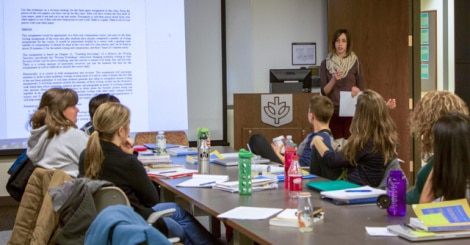How do people learn to write? And how can teachers best facilitate this learning?
This quarter, MA students in Professor Darsie Bowden’s course, WRD 540: Teaching Writing, have been exploring the answers to these questions. Bowden explains that the course aims to bring together teaching practices and the theories that inform them. Her students have had the opportunity to design their own activities and assignments, often collaboratively, and then to “teach” these lessons to their classmates.
For many students, it is the hands-on teaching experience the course offers that is most exciting. Says student Katie Martin,
It’s so practical! We’re creating activities that we can use in our classrooms in the future.
And there is more hands-on learning to come: this week (week 8 of the course) students will practice commenting on first-year-writing students’ papers—a topic Bowden is particularly interested in, as evidenced by the research she’s conducting on how students respond to their instructors’ feedback. In fact, she intends to share early results of her research to help guide and inform class discussion. Bowden explains that, though the research is still in its early stages, preliminary results suggest patterns in what types of comments students find helpful, unhelpful, or even confusing. Furthermore, she says that the research demonstrates “the degree to which students’ perception of feedback varies based on their writing experience and confidence.” She looks forward to discussing how these preliminary findings support and challenge current practices.
Bowden led a task force that revised the WPA (Writing Program Administrators) Outcomes Statement. Initially drafted in 2001, the new 2014 revision incorporates a broader definition of “writing” to include multimodal writing. The Outcomes Statement, with a companion piece that articulates the nature of these changes was just published in the WPA Journal. These outcomes emphasize the importance of rhetorical knowledge and the ability to write in a variety of contexts for a variety of audiences—points that Bowden emphasizes in WRD 540 when teaching MA students how to design activities and create assignments.
Next quarter, a number of WRD 540 students plan to apply to the Teaching Apprenticeship Program (TAP), through which they will have the opportunity to teach their own sections of first-year writing at DePaul, with the support of a cohort of other students and in tandem with a practicum course, also taught by Bowden, WRD 551.
